
| Board 6 | Orchard Terrain |
| Board 7 | River Terrain |
| Scenarios: 21-32 | |
Crescendo of Doom is a board game published in 1980 by Avalon Hill.

| Board 6 | Orchard Terrain |
| Board 7 | River Terrain |
| Scenarios: 21-32 | |
Crescendo of Doom is a board game published in 1980 by Avalon Hill.
Crescendo of Doom is an expansion for Squad Leader (called gamettes by the publisher).
COD provides blanket coverage to the Western Front of 1939–1941, including French and British infantry, vehicles and ordnance (most tanks and guns being palpably less powerful than the late-war equipment in the previous gamette, giving an interesting feel to the scenarios) as well as infantry for Finland - elite troops who had the rare ability to rally themselves without the presence of a leader - and the "Allied Minors" including Belgium, Norway, Poland and the Netherlands. Like COI, a complete order of battle of British and French armor and ordnance is included, though American built vehicles in British service are not included (which was consistent with the pre-1942 timeframe of the gamette). Whereas COI expands the armor and artillery rules, COD gives more nuanced rules regarding the infantry and other foot soldiers, including such things as cowering and pinning, while introducing Scouts and morale disadvantages for early war infantry facing off against tanks. Additionally, many new terrain types are introduced on the two new mapboards, including marsh, river, large bridges, and orchards, as well as no less than three kinds of boats to cross a river with - Scenario 27 covers the crossing of the Meuse at Dinant by parts of the German 7th Panzer Division, with a highly-rated leader counter deemed to represent Erwin Rommel himself taking personal command.
Even before Squad Leader debuted, plans were being made to expand the initial release; these expansions would be called "gamettes" and concentrate on particular eras or theatres, all the while developing the basic game system with additional rules, new weapons types, and different terrain.
Just as COD was finalizing its playtesting, plans were made for two further gamettes; the September–October 1979 issue of The General Magazine announced that GI: Anvil of Victory would include both American and Italian forces, and that a fifth and final gamette covering the Japanese would be released a year after that.
Three sets of "official" scenarios were released by Avalon Hill directly. Series 200 (scenarios 201-210) was designed for Crescendo of Doom.
Lorrin Bird described the current state of the armor game after COD's release in an article printed in Special Issue #2 of Campaign Magazine:
While the original Squad Leader game was a work of art with regard to its fine balance of playability and detail...the gamettes are coming to represent the "masterpieces" of wargamedom due to the unbelievable trivia that is included. From radioless AFV's to the benefits/handicaps of having the commander exposed, the expanding Squad Leader system is investigating and providing rules for many features of WWII armored combat that were previously overlooked in other boardgames and even miniature systems...The end result of the amazing efforts being made to make the SL system as complete as possible is that one is presented with tanks which act pretty much like they did in real life...
James Collier, in a piece entitled "Glass Anvil: A Dissenting View of GI: Anvil of Victory", presented in Volume 20, Number 1 of The General, described the situation:
By now it should be recognized that the Squad Leader series is virtually unique among WWII board games by being a game in evolution. The succeeding gamettes have not been mere additions to the original, but instead have introduced substantial revisions to the original parameters. This is even more true with GI where the bulk of both components and rules represent revisions rather than new material. There are, for example, only 300 more counters than provided with CRESCENDO OF DOOM, and well over half the GI counters represent replacements for counters previously introduced (only a handful of the original SL counters are still usuable (sic) in their printed form)...
Though one must pay the price of forfeiting obsolete materials above and beyond the purchase price, the loss can be accepted as the cost of progress. There are few who would quibble with the appropriateness of the added dimensions of the revised vehicle and ordnance counters presented in CROSS OF IRON. That process is, of course, carried forward in COD and GI to include the relevant nationalities. Now GI introduces a similar order of revision for the infantry counters in addition to a number of new maneuvers and capabilities. As this evolution continues, one is eventually compelled to ask where it is going and why?

Axis & Allies is a series of World War II strategy board games. The first version was initially published in 1981 and a second edition known colloquially as Axis & Allies: Classic was published in 1984. Played on a board depicting a Spring 1942 political map of Earth divided by territories, players take the role of one or more of the five major belligerents of World War II: the Axis powers of Germany and Japan; and the Allied powers of the Soviet Union, the United Kingdom, and the United States. Turn rotates among these belligerents, who control armies of playing pieces with which they attempt to capture enemy territories, with results determined by dice rolls.
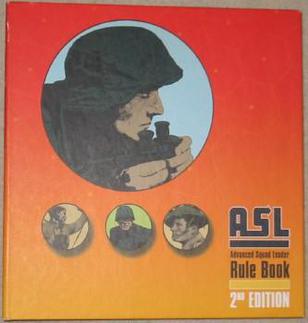
Advanced Squad Leader (ASL) is a tactical-level board wargame, originally marketed by Avalon Hill Games, that simulates actions of squad sized units in World War II. It is a detailed game system for two or more players. Components include the ASL Rulebook and various games called modules. ASL modules provide the standard equipment for playing ASL, including geomorphic mapboards and counters. The mapboards are divided into hexagons to regulate fire and movement, and depict generic terrain that can represent different historical locations. The counters are cardboard pieces that depict squads of soldiers, crews, individual leaders, support weapons, heavy weapons, and vehicles.

PanzerBlitz is a tactical-scale board wargame published by Avalon Hill in 1970 that simulates armored combat set in the Eastern Front of the Second World War. The game is notable for being the first true board-based tactical-level, commercially available conflict simulation (wargame). It also pioneered concepts such as isomorphic mapboards and open-ended design, in which multiple unit counters were provided from which players could fashion their own free-form combat situations rather than simply replaying pre-structured scenarios. Over the next ten years, it became the most popular board wargame of its time.

Squad Leader is a tactical level board war game originally published by Avalon Hill in 1977. It was designed by John Hill and simulates on infantry combat in Europe during World War II. One of the most complex war games of its time, Squad Leader is the natural extension of the trend towards greater realism initiated by several earlier games, including Avalon Hill's own PanzerBlitz and Panzer Leader. Those two earlier games were slightly larger in scope, with counters representing platoons and map hexes measuring 250 metres across, compared to Squad Leader's 40 meter hexes and squad sized units.
Modules for the game Advanced Squad Leader (ASL) contains all the equipment needed to actually play the game. There are 14 official so-called "core" modules that contain the essential components for a complete order of battle of all major nationalities to participate in the Second World War. Ownership of all core modules is not a prerequisite to playing the game, and as few as one module can be used. In addition to core modules, other products are also available and may be loosely referred to as "modules", or in the more specific terms as Deluxe ASL Modules and Historical ASL Modules. These required previous ownership of some of the core modules in varying combinations, or at least the components of them.
Squad Leader is a game system depicting tactical combat in the Second World War. The game and three additional gamettes are open-ended, a trend in tactical board wargaming beginning from the 1970s and most notably seen in Avalon Hill's highly successful PanzerBlitz. The use of geomorphic mapboards and counters representing small tactical units gave the game great flexibility and the potential to recreate a wide range of situations.

Tactical wargames are a type of wargame that models military conflict at a tactical level, i.e. units range from individual vehicles and squads to platoons or companies. These units are rated based on types and ranges of individual weaponry. The first tactical wargames were played as miniatures, extended to board games, and they are now also enjoyed as video games.
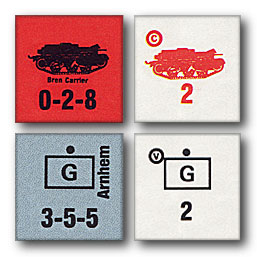
A counter is usually a small cardboard square moved around on the map of a board wargame to represent relevant information or determine certain things. The first wargame based on cardboard counters was War Tactics or Can Great Britain Be Invaded? invented by Arthur Renals of Leicester in 1911. The first wargame bringing counters to a mass-market was Tactics, invented by Charles S. Roberts in 1952. Traditional wargames typically have hundreds of counters. Squad Leader had counters of different sizes: 520 1⁄2-inch counters and 192 5⁄8-inch, with the different sizes used for different purposes.

Axis & Allies Miniatures is a miniature wargaming system including both a rule set and a line of 1/100 scale miniature armor collectible miniatures. The game is set in the World War II era with units representing individual vehicles and artillery or squads of infantry. The system was first released in 2005 and was produced by Avalon Hill, a division of the game company Wizards of the Coast, which itself is a subsidiary of Hasbro.
Panzer Leader is the sequel to Avalon Hill's PanzerBlitz game.

Don Greenwood is a board game designer and was a pioneer editor among commercial board-wargaming magazines. He began his own fanzine, Panzerfaust Magazine, which he oversaw from 1967 until 1972. He then joined The Avalon Hill Game Company in 1972, and took over editorship of that company's "house organ", The General Magazine, which office he held until 1982. He left Avalon Hill and continued to work in the wargame industry, notably for GMT Games. He is the founder of the Origins, Avaloncon, and WBC gaming conventions and remains the WBC convention manager. Greenwood was also president of the Boardgame Players Association. He was inducted into the Origins Award hall of fame in 1991 and the Charles Roberts Awards Hall of Fame in 1994. He was honored as a "famous game designer" by being featured as the king of spades in Flying Buffalo's 2011 Famous Game Designers Playing Card Deck.

Tobruk, subtitled "Tank Battles in North Africa 1942", is a board wargame published by Avalon Hill in 1975 that simulates tank combat in North Africa during World War II.
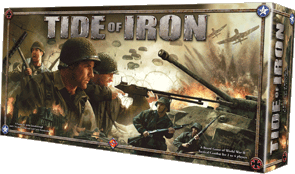
Tide of Iron is a World War II based wargame designed and published in 2007 by Fantasy Flight Games, also notable for publishing other large games containing a large number of counters and/or other components such as World of Warcraft: The Board Game and Arkham Horror.

Micro armour refers to scale models made of lead, pewter, die cast metal or plastic, usually used for wargaming purposes. Variations of the name include: mini armour, microscale, mini tanks, miniature armour, miniature tanks, micro tanks, minitanks, minifigs, armour figurines, tank figurines, etc. are also used. Micro armour is a sub-category of model military vehicle miniature figures used for military simulation, miniature wargaming, scale models, dioramas and collecting.

Combat Mission is the name of a successful series of computer wargames simulating tactical battles. The series has progressed through two distinct game engines. The original game engine, referred to as 'CMx1' by the developer, Battlefront.com, powered a trio of games set in the Second World War. Combat Mission: Shock Force was released in July 2007 as the debut of the 'CMx2' game engine. The Combat Mission games are a mixture of turn-based gameplay and simultaneous real-time execution. The game environment is fully three-dimensional, with a "Wego" style of play wherein each player enters their orders into the computer simultaneously during pauses in the action, and then are powerless to intervene during the action phase. More familiar turn-based games use an "I-go/You-go" system of play.

Cross of Iron is a tactical board wargame published in 1979 by Avalon Hill as an expansion — called a "gamette" by the company — to their very popular 1977 wargame Squad Leader. The game simulates small group tactical combat during World War II on the Eastern Front.
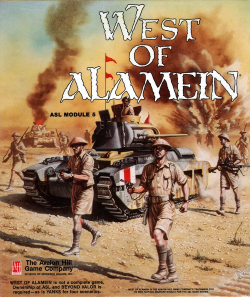
West of Alamein is a board wargame published by Avalon Hill in 1988 that simulates combat in North Africa during World War II.

MBT is a board wargame published by Avalon Hill in 1989 that simulates hypothetical World War Three tank combat between NATO and Warsaw Pact forces in Western Europe. A second edition was published by GMT Games in 2016.

KampfPanzer: Armored Combat, 1937–40 is a board wargame published by Simulations Publications Inc. (SPI) in 1973 that simulates the first battles involving battle tanks.
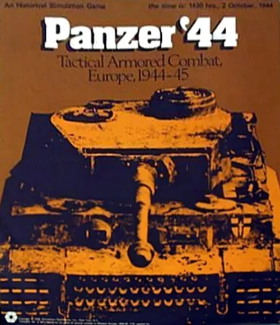
Panzer '44: Tactical Combat in Western Europe, 1944–45 is a board wargame published by Simulations Publications Inc. (SPI) in 1975 that simulates historical tank combat during World War II.